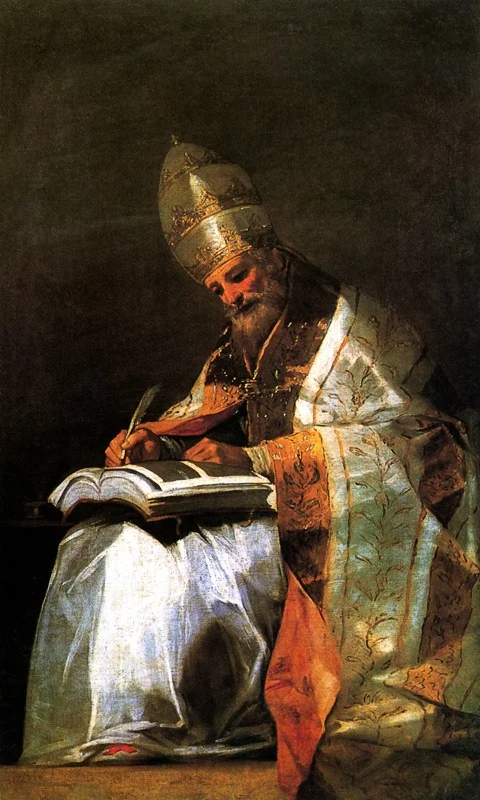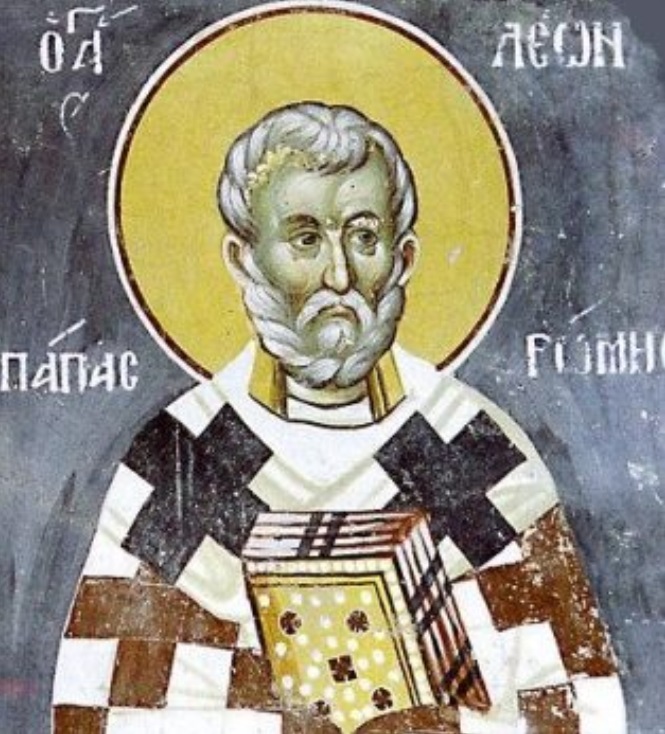
Catholic Saints
Saint Leo the Great (c. 400–461 AD), Pope from 440 to 461 AD, was a fifth-century titan of the Church, earning the title "the Great" for his theological precision and diplomatic valor amid a crumbling Roman Empire. Rising to the papacy during an era of barbarian invasions and internal ecclesiastical strife, he navigated a world where secular power faltered, yet the Church’s influence soared under his steady hand. A Doctor of the Church, he is famed for his Tome, which defined Christ’s two natures at the Council of Chalcedon in 451 AD, and for persuading Attila the Hun to spare Rome in 452 AD. His sermons and letters shaped Western Christianity, offering a beacon of stability as the empire fragmented, and his feast day is celebrated on November 10. Named a Doctor of the Church in 1754 by Pope Benedict XIV, Leo’s legacy blends pastoral care with resolute leadership, cementing his place as one of history’s most impactful pontiffs whose vision extended beyond his time to fortify the Church’s foundations for centuries to come.
His feast day is celebrated on November 10.
Doctor of the Church
Born around 400 AD, Saint Leo the Great rose to lead the Church as Pope from 440 to 461 AD, wielding theological clarity and diplomatic courage to guide Christianity through a fracturing empire.
Leo was born around 400 AD, likely in Tuscany or Rome, to an aristocratic family in the waning years of the Western Roman Empire. Little is known of his youth, but his education in rhetoric and theology marked him as a rising figure in the Church. By the 430s, he served as a deacon under Popes Celestine I and Sixtus III, gaining renown for his administrative skill and doctrinal insight.
In 440 AD, while on a diplomatic mission in Gaul to reconcile warring factions, Leo was elected Pope following Sixtus III’s death—a rare instance of a pontiff chosen in absentia. His early career foreshadowed his ability to unite disparate elements, a trait that would define his papacy amid barbarian invasions and ecclesiastical disputes.
As Pope from 440 AD, Leo centralized Church authority, asserting Rome’s primacy over other sees—a stance rooted in his belief in Peter’s apostolic succession. He reformed clerical discipline, combated abuses like simony, and standardized liturgical practices, strengthening the Church’s structure as the empire crumbled around it.
Leo’s 96 surviving sermons, delivered often on feast days, reveal a pastor’s heart, emphasizing Christ’s incarnation and the call to holiness. His leadership faced immediate tests—negotiating with barbarian tribes and addressing heresies like Pelagianism, which he condemned for denying original sin’s impact—setting a tone of resolute guidance.
In 452 AD, Leo achieved a feat that cemented his legend: meeting Attila the Hun at the River Mincio near Mantua. As the Huns ravaged northern Italy, threatening Rome, Leo, accompanied by a small delegation, persuaded Attila to withdraw. Tradition attributes this to divine intervention—visions of Saints Peter and Paul—or Leo’s diplomatic prowess, possibly aided by tribute.
This encounter, following his earlier mediation with the Vandals in 455 AD (mitigating Rome’s sack), showcased Leo’s role as a temporal protector. Though Rome’s political power waned, his actions bolstered the papacy’s moral authority, earning him the epithet “the Great” in a time of crisis.
Leo’s theological masterpiece, the Tome of 449 AD, addressed the Monophysite heresy, which claimed Christ had only one nature. Sent to the Council of Ephesus (later deemed a “Robber Synod”), it was initially ignored, but its clarity—affirming Christ’s two natures, divine and human, in one person—won out at the Council of Chalcedon in 451 AD.
Chalcedon, convened under Emperor Marcian, hailed the Tome as the definitive statement of orthodoxy, with bishops proclaiming, “Peter has spoken through Leo.” This triumph over Monophysitism, building on Cyril of Alexandria’s work, solidified the Church’s Christological doctrine, a cornerstone of Leo’s legacy as a Doctor of the Church.
Beyond Chalcedon, Leo’s 143 surviving letters tackled heresies like Manichaeism and Priscillianism, reinforcing orthodoxy across the empire. His correspondence with bishops in Africa, Spain, and Gaul extended Rome’s influence, while his sermons—rich with themes of charity and redemption—offered spiritual guidance to a beleaguered flock.
Leo’s writings emphasized the Incarnation’s mystery, linking it to human salvation, and his pastoral tone made complex theology accessible. His efforts to unify doctrine amidst diversity earned him recognition as a Doctor of the Church in 1754 by Pope Benedict XIV, a title reflecting his enduring intellectual impact.
Leo died on November 10, 461 AD, in Rome, after a 21-year papacy that fortified the Church against collapse. Buried in St. Peter’s Basilica, his tomb became a pilgrimage site, and his feast day, November 10, honors his dual role as shepherd and statesman. His writings influenced medieval theology, notably inspiring figures like Gregory the Great.
Saint Leo the Great’s legacy lies in his fusion of theological precision and practical leadership. Facing invasions and heresies, he upheld Rome as the Church’s heart, leaving a model of papal authority and doctrinal fidelity that resonates today. His life calls believers to courage and clarity in turbulent times.
“The birth of Christ is the source of life for Christian people, and the birthday of the Head is the birthday of the body.”
Born, likely in Tuscany or Rome.
Educated in rhetoric and theology.
Began papacy amid empire’s decline.
Became Pope Leo I.
Council of Chalcedon affirmed Tome.
Defined Christ’s two natures.
Persuaded Huns to spare Rome.
Met Attila the Hun.
Died in Rome.
Named Doctor of the Church in 1754.

“Virtue is nothing without the trial of temptation, for there is no conflict without an enemy, no victory without strife.”
Saint Leo the Great Quotes
“The Son of God entered into this world’s lowliness that man might be exalted to the highest heights.”
“Peace is the first thing the angels sang. Peace is the mark of the children of God.”
“The faithful are born not of blood, nor of the will of the flesh, but of God.”
“He that sees all things and knows all hearts is our witness that we seek not our own glory, but yours.”
“The dignity of the priesthood is nowhere more brilliantly displayed than when it administers the sacraments.”
“Let us rejoice that the Lord has given us such a Head, whose guidance we may safely follow.”